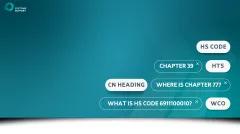What is an HS-Code?
HS-Code stands for Harmonized System Code. It is developed and maintained by the World Customs Organization in Brussels. HS-Codes are used by Customs Authorities worldwide to categorise products. Based on the HS-Code of the product you want to export there are specific requirements, import duties, tariffs, or taxes you may need to pay.
What does an HS-Code look like?
The HS-Code is a six, eight, ten, or twelve digit number. The first six are the same worldwide. The numbers after that differ per country. Be aware of this if you have foreign suppliers sending you codes for the parts you get from them.
Let’s take an electric guitar as an example. The correct HS-Code is: 9207 90 10 00. This code is based on the EU’s TARIC goods nomenclature database on the Dutch Customs website. In this case 10 00 is a further categorization by the Dutch Customs Authority.
9207 90 10 00 = CHAPTER 92 – MUSICAL INSTRUMENTS; PARTS AND ACCESSORIES OF SUCH ARTICLES
9207 90 10 00 = Musical instruments, the sound of which is produced, or must be amplified, electrically (for example, organs, guitars, accordions)
9207 90 10 00 = Other
9207 90 10 00 = Guitars
Where Do I Get an HS Code?
Assigning an HS Code to a product is called HS Classification. Classifying a product can be done based on its function, form, or composition. It can be a difficult and challenging process.
For example:
“HS classification is not always straightforward. Many automotive parts, for example, are not classified under heading 87.08, which provides for Parts and accessories of the motor vehicles of headings 87.01 to 87.05. Automotive seats are classified as articles of furniture under heading 94.01, which provides for Seats (other than those of heading 94.02), whether or not convertible into beds, and parts thereof, and more specifically under subheading 9401.20, which provides for Seats of a kind used for motor vehicles.” – Source: Wikipedia
There are several websites that can help you find the right HS Code for your product:
The Official Explanatory Notes to the Harmonized System, published by the World Customs Organization. The Explanatory Notes provide a commentary on the scope of each heading, giving a list of the main products included and excluded, together with technical descriptions of the goods concerned (their appearance, properties, method of production and uses) and practical guidance for their identification.
EU: Explanatory notes to the Combined Nomenclature of the European Union by the European Commission
US: The US Census “Classify your Commodity” engine
UK: Classification Guides, by HM Revenue & Customs
What Happens When a Product is Classified Incorrectly?
Incorrectly classifying a product can lead to non-compliance penalties, border delays, seizure of the products, or even a denial of import privileges. As the exporter of the products, you are responsible for correctly classifying them, and therefore you are liable. Because classifying is complicated this can be a risk.
When in doubt it is best to seek expert advice and let AEO certified customs specialists classify your products. Read more about our customs services.














